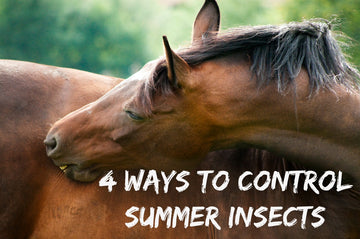Blog
Four Ways To Control Summer Insects

While we begin the summer months, insect control around our barns becomes very important. These pesky insects can make your horse’s life a nightmare - it's time to control summer insects!
Here are several ways to help control insects around your farm:
1. Eliminate Breeding Grounds - One of the best and most important things you can do to control insects is to eliminate the insects breeding grounds. Most insects lay their eggs in manure. Remove all droppings from the stalls and around the barnyard. Also, keep in mind your pastures. The manure should be removed from pastures as well. This can be done several ways. One of which is to simply go through with a pitchfork and wheelbarrow and pick it up, pile by pile.
Another way would be to drag your pasture with a harrow or even just a heavy piece of wood. This will break up the manure allowing it to dry out in the sun faster, making it less attractive to flies. Insects also breed in water. Be sure to dump anything that will collect water on a regular basis such as feed tubs, buckets, and water troughs. This should be done every few days in order to keep insects down.
2. Turnout Time - Many insects are most prevalent during daylight hours when temperatures are at their peak. Turn your horses out in the early morning or during the night. This strategy may not work for everyone. If mosquitoes are thick in your area, do not turn your horses out at night. This will depend on your location.
3. Fly Mask, Sheets, and Leg Wraps - There are several different types of horse clothing that can be used to protect your horse from insects. Fly masks are very popular. These are placed on the horses head to keep insects away from sensitive areas of the face such as the eyes and ears. A fly sheet is similar to a turnout sheet. A fly sheet is made out of a strong mesh that is very fine. It is used to keep flies and other insects off of your horse but can also help protect your horse from sun bleaching. Leg wraps are a relatively new product on the market. These leg wraps are lined with fleece to keep crawling insects out.
4. Fly Repellents - There are many different types of fly repellents out there. They can be separated into two main categories - natural or chemical preparations. These fly repellants can be found in spray form or wiped directly on the horse. Roll-on fly repellants can also be used. They are mainly used on the horse’s face and ears.
Insect control should be a main focus for any barn or horse owner as these pesky insects can carry many different diseases. Use these four steps to help you and your horses! For more information on insect control, visit: http://equisearch.com/article/summerbugs062897





















